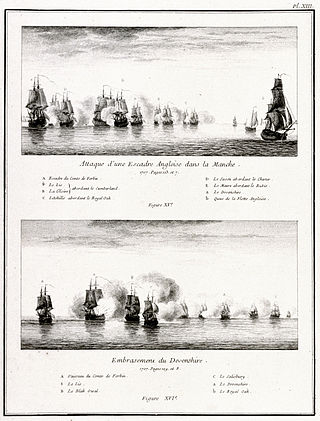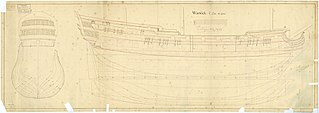
HMS Victory was a 100-gun first-rate ship of the line of the Royal Navy, built to the dimensions of the 1733 proposals of the 1719 Establishment at Portsmouth Dockyard, and launched on 23 February 1737.
HMS Assistance was one of six 40-gun fourth-rate frigates, built for the Commonwealth of England under the 1650 Programme, after the Restoration of the monarchy in 1660 she was incorporated into the navy of the Kingdom of England. During her time in the Commonwealth Navy she partook in the First Anglo-Dutch war being present in the battles of Kentish Knock, Portland and The Gabbard. In the Mediterranean she was present at the Battle of Santa Cruz and the bombardment of Porto Farina, In the Second Anglo-Dutch War she was involved in the Battle of Lowestoft, Battle of Vagen and the St James Day Fight. She did not participate in fleet actions after this. She spent the rest of her service life undergoing several rebuilds and plying the waters as a cruiser protecting British trade and projecting British sovereignty. After nearly 95 years of Service she was sunk as a break water at Sheerness at the end of 1745.

HMS Salisbury was a 50-gun fourth rate ship of the line of the Royal Navy, built by Richard and James Herring at Baileys Hard on the Beaulieu River in Hampshire, England, and launched on 18 April 1698.
HMS Greenwich was a 50-gun fourth rate ship of the line of the Royal Navy. She was built during the War of the Austrian Succession, and went on to see action in the Seven Years' War, during which she was captured by the French and taken into their service under the same name. She was wrecked shortly afterwards.

HMS Lenox was a 70-gun third rate built at Deptford Dockyard in 1677/78. She was in active commission for the War of English Succession fighting in the Battles of Beachy Head and Barfleur. She was rebuilt in 1699. Again in active commission for the War of Spanish Succession fighting in the Capture of Gibraltar and the Battle of Velez Malaga. She followed this with the Battle off Passero. She was rebuilt again in 1721. She was active in the War with Spain, capturing the Princesa then serving in Home Waters, the Mediterranean and finally the West Indies. She was in action off Havana in 1745. She returned home and was placed in Ordinary. She was finally sunk as a breakwater at Sheerness in 1756.

HMS Essex was a 70-gun third rate built by Sir Henry Johnson of Blackwall in 1678/79. During the War of the English Succession she fought in the last major action. She was rebuilt in 1699/1700. During the War of Spanish Succession she fought at Vigo Bay, the Capture of Gibraltar and Velez Malaga. She also fought at the Battle off Passero in 1718. She was rebuilt again in 1736-40. She was in action off Toulon in 1744. She was active in the Channel and against French ports during the Seven Years War. She fought at Quiberon Bay in 1759. She was wrecked in Quiberon Bay in November 1759.

HMS Expedition was a 70-gun third-rate ship of the line built at Portsmouth Dockyard in 1677/79. She was in active commission during the War of the English Succession participating in the battles of Beachy Head and Barfleur. She was rebuilt in 1699. Again, for the War of Spanish Succession she was in commission for the operation at Cadiz then returned to England where she sat for two years. She was in the Mediterranean for the Battle of Marbella in 1705. She then went to the West Indies and fought in Wager's action off Cartagena in 1708. She was rebuilt in 1709-14 to the 1706 Establishment. She spent her time split between the Baltic and as guard ship at Portsmouth before being broken at Portsmouth in 1736. She was rebuilt in 1736/40 at Deptford Dockyard.

HMS Kent was a 70-gun third rate ship of the line built by Sir Henry Johnson of Blackwall in 1677/79. She served during the War of English Succession 1699 to 1697, participating in the Battle of Barfleur. She was rebuilt in 1697/99. She served during the War of Spanish Succession 1702 to 1712 and partook in the Battles of Vigo and Velez-Malaga. She partook in the Battle of Passaro then served during the short war with Spain, December 1718 to February 1720. She was rebuilt in 1722/26. She spent the next thirteen years as a guard ship at Portsmouth. In the 1740s, she was off Cape Finisterre then in the West Indies. She returned home and was finally broken in 1744.

HMS Suffolk was a 70-gun third-rate ship of the line of the Royal Navy, built by contract of 20 February 1678 by Sir Henry Johnson at Blackwall. She participated in the War of the English Succession 1689 - 1697, in the Battles of Beachy Head and Barfleur. She was rebuilt in 1699. She was actively involved in the War of Spanish Succession 1702 - 1713. Her later career was as guard ship duties, deployments to the Baltic Sea and the West Indies. She was finally broken in 1765 after lying in Ordinary for almost twenty years.
HMS Newcastle was a 50-gun fourth rate ship of the line of the Royal Navy, built by Joseph Allin the elder at Sheerness Dockyard and launched on 10 March 1704.

HMS Burford was a 70-gun third rate ship of the line of the Royal Navy, built at Deptford Dockyard to the 1719 Establishment, and launched on 19 July 1722. Burford was notably the early posting of both John Forbes and John Byng, both of whom rose to become admirals.
The 1719 Establishment was a set of mandatory requirements governing the construction of all Royal Navy warships capable of carrying more than 20 naval long guns. It was designed to bring economies of scale through uniform vessel design, and ensure a degree of certainty about vessel capability once at sea, and was applied to all vessels from the first-rate to the fifth-rate. Once in effect, it superseded the 1706 Establishment, which had specified major dimensions for ships of the second-rate, third-rate and fourth-rate only.

HMS Warwick was a 60-gun fourth-rate ship of the line of the Royal Navy, built to the 1719 Establishment at Plymouth by Peirson Lock. The keel was laid down on 1 April 1730, and the ship was launched on 25 October 1733, and completed on 24 August 1734.

HMS Eagle was a 58-gun fourth rate ship of the line of the Royal Navy built at King's Yard in Harwich by John Barnard and launched in 1745.

The 1745 Establishment was the third and final formal establishment of dimensions for ships to be built for the Royal Navy. It completely superseded the previous 1719 Establishment, which had subsequently been modified in 1733 and again in 1741. Although partially intended to correct the problems of the ships built to the earlier Establishments, the ships of the 1745 Establishment proved just as unsatisfactory, and important changes in the make-up of the Admiralty and Navy Boards finally led to the end of the establishment era by around 1751.
HMS Swift was an 8-gun snow-rigged sloop of the Royal Navy, the last of three Drake class sloops constructed during the Anglo-Spanish War of Jenkins' Ear. Launched in 1741, her principal service was as convoy escort and patrol off North Carolina and in the North Sea. She was lost at sea on 31 October 1756.
HMS Gibraltar was the name ship of the Gibraltar Group of 24-gun sixth rates. After commissioning she spent her career in Home waters and North America on trade protection duties. She was rebuilt at Deptford between 1725 and 1727. After her rebuild, she served in Home Waters, North America, the West Indies, and the Mediterranean on trade protection. She was sold in 1749.
HMS Scarborough was a 32-gun fifth rate built under contract by James Parker of Southampton in 1695/96. She served in the trade protection and counter-piracy operations during her service. She was captured by the French, then recaptured by the British and renamed Garland, She was converted to a fireship for the Baltic then the Mediterranean. She was at the Battle of Passero in 1718. She was reduced to a 20-gun sixth rate in 1717. Rebuilt to the 1719 Establishment in 1721, she was finally sold in 1744.
HMS Lowestoffe was a 32-gun fifth rate built at Chatham Dockyard in 1696/97. She spent her career on counter piracy patrols and trade Protection duties. She participated in the capture of Port Royal in Nova Scotia. She was rebuilt in 1722/24 as a 20-gun sixth rate. She was sold in July 1744.
HMS Tartar was a 32-gun fifth rate built by the Woolwich Dockyard in 1702. Her initial commissioning was in time for the War of the Spanish Succession. She partook in the Battle of Velez Malaga in 1704. She spent the rest of her career on counter piracy and trade protection patrols. She was rebuilt as a 20-gun sixth rate in 1733. She was finally broken in 1755.










